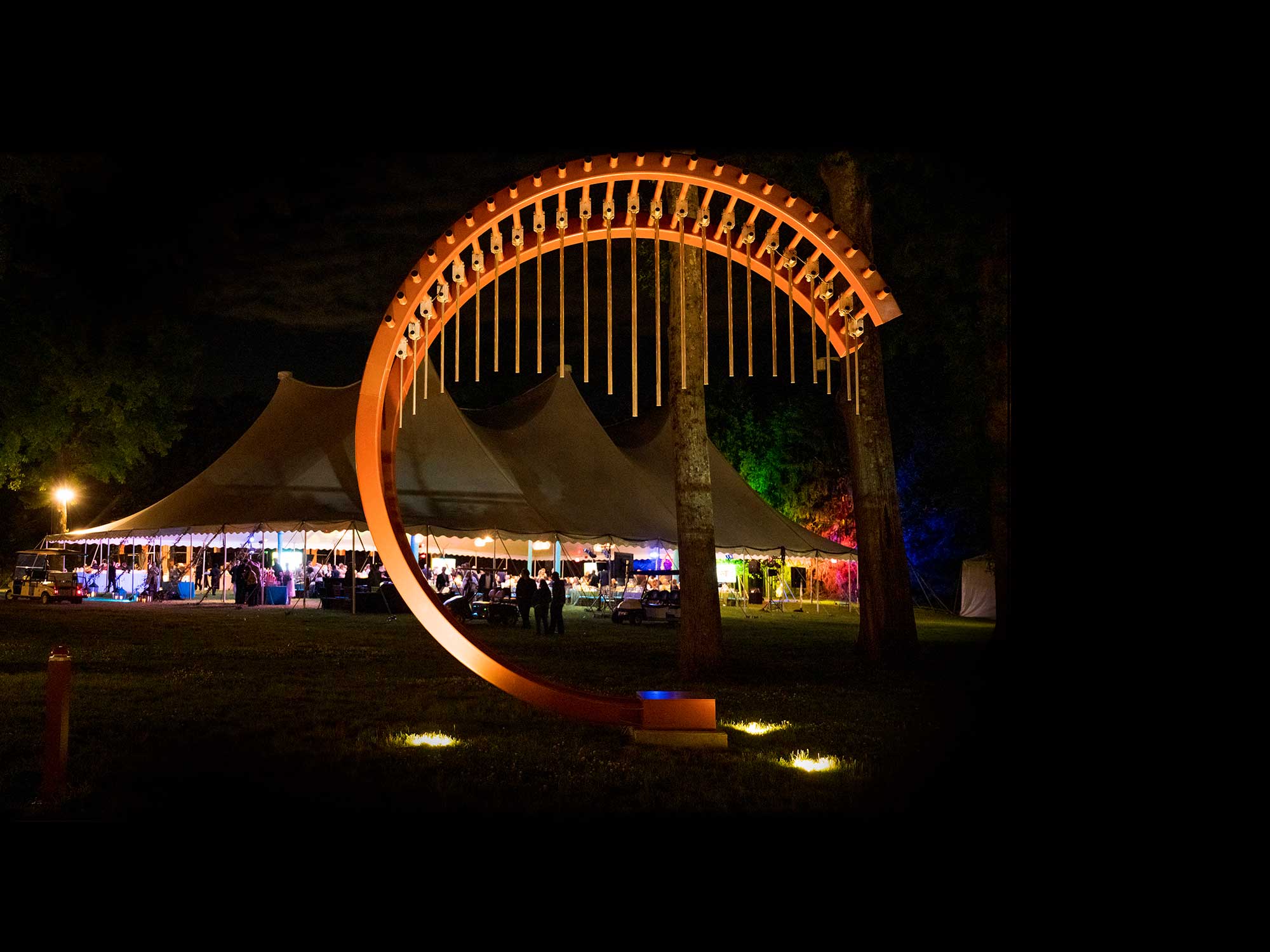Writing by Gia Miller
Photography by Gabe Palacio
In 1929, Caroline Moore Hoyt sold her Katonah property, which she’d named Caramoor, to Walter Tower Rosen and Lucie Bigelow Rosen. Walter was a Berlin-born, international banker who specialized in railroads, and Lucie was described as an “independent, spirited and highly intelligent member of a prominent New York City family.”
As the Rosens built their new home, they turned to their travels abroad and passion for music as inspiration.
“They were great lovers and patrons of music,” says Jessa Krick, Caramoor’s director of interpretation, collection and archives. “They played music themselves –Walter played the piano and Lucie played the theremin.”
As they built their home over the next decade, they brought in complete 18th-century rooms originally from private villas and chateaux in Italy, France and England. Then, they filled those (and other) rooms with fine and decorative Asian and Renaissance art. They also “built it for music,” as Lucie once said.
Quirky roots
Lucie had a particular affinity for the world’s first electronic instrument – the theremin. Originally called the etherphone because it appeared as though sound was produced with air, the theremin was often considered the strangest instrument ever invented. The instrument was a large wooden box (modern versions are much smaller) with two wires, and it’s played by the musician moving their hands in the air, never actually touching the instrument.
The theremin was accidentally invented in 1919 by Russian physicist and cellist Léon Theremin (he was also a spy, but that’s another story) who was working on a gas meter to measure the density of gas. He noticed different squeals as he brought his hand closer to and away from the meter; soon, he was playing melodies, and then he developed his musical instrument.
The Rosens financially supported Theremin’s work, and in return, he built a custom theremin for Lucie, which is on display in the Rosen House. She championed this instrument whenever she could, performing around the world, including at Carnegie Hall with nine other theremin musicians (and Leon Theremin) in 1930.

Walter Tower Rosen and Lucie Bigelow Rosen.
Welcoming music
Since the Rosens began hosting friends in the 1930s, music has played an important role at Caramoor. It all started with intimate concerts in their living room for their local and international friends.
When the Rosen’s son, Walter Bigelow Rosen (a member of the Royal Canadian Air Force) died several days after a plane crash in 1944, they bequeathed their estate in his memory. In 1945, Caramoor became a center for music and art, offering public concerts.
In February 1946, the Rosens used their new public-facing venue to introduce even more people to Lucie’s beloved instrument with a concert featuring Lucie playing the theremin, soprano Alice Husted and Walter on the piano. That summer, the Music Room opened to the public for three summer concerts.
Global culture
Taking a cue from the Rosens’ love of global music and culture, part of Caramoor’s mission was/is to create an international music experience.
When African American contralto Marian Anderson performed at the opening of the Venetian Theater in June 1958, Caramoor proved itself a welcoming place for high-quality diverse performers. Since that time, the list of international performers at the Venetian Theater and throughout the five performance venues on Caramoor’s property has been extensive, including Mitsuko Uchida, Andre Previn, Yo-Yo Ma, Cecilia Bartoli, Jacqueline du Pre, Daniel Barenboim, Helene Grimaud, Daniil Trifonov and Christian Tetzlaff.
“We feel a vibrant Caramoor season should include a broad variety of music genres,” says Kathy Schuman, Caramoor’s vice president and artistic director. “I always aim to choose a balance of returning artists and debuts, well-established and rising ‘stars,’ and artists of different ages, genders, races, and backgrounds to ensure we’re representing diverse voices on our stages.”
This year is no different. One of the international acts will be the Ukrainian quartet DakhaBrakha (July 14) – a group that’s managed to combine folk music with rock, punk, hip-hop and cabaret, along with some powerful vocals and a lot of spunk.
Another is London-born composer and bassist Michael Olatuja (August 16) whose music blends sounds from Lagos, Nigeria, London and New York (his current home). Olatuja, who describes his music as “cinematic Afrobeat,” has worked with hundreds of artists, from Kurt Elling and Jose James to Stevie Wonder and Shakira.
“Recognized for its rich and storied history, Caramoor continues to build upon that legacy as a leading cultural center in the region,” says President and Chief Executive Officer Edward J. Lewis III. “True to the vision of our founders, Walter and Lucie Rosen, Caramoor is a place where you can be transformed by the convergence of an exciting and diverse mix of remarkable live music performances, beautiful gardens and grounds, innovative outdoor sound art and art-filled historic home. As we enjoy our 78th summer season, Caramoor is poised to become a model of a vibrant and relevant twenty-first-century cultural center.”

Music in the woods
Almost ten years ago, Caramoor expanded its musical repertoire beyond its five distinct concert venues so guests could always hear music throughout the property. In 2014, renowned sound artist Stephan Moore curated Caramoor’s first outdoor sound art exhibition, and he’s continued to build Caramoor’s collection ever since.
The 2014 installation “Wild Energy” allows you to hear the vibrations and sounds of our natural universe and “Stone Song” features tones that slowly shift as the stone sculpture settles into the earth.
In 2017, t(ch)ime was installed, which plays digitally-manipulated bell chimes throughout a path in the woods. There’s also a handmade white oak rocking chair, installed in 2018, that activates the speakers in the trees when you sit and rock.
In 2021, the now iconic “C” that welcomes you to Caramoor was installed; it’s composed of 24 metal bell chimes that you can play with the push of a button. Also in 2021, a beyond-repair piano was installed off the beaten path. If you can find it, you are encouraged to play it until “environmental forces make it dangerous or impossible to do so.”
“Timbre” and “Frequency,” installed in 2022, are located on opposite sides of Caramoor, but they complement each other (“like the A side and B side of a record,”). “Timbre” plays music based on Toni Morrison’s novel “The Bluest Eye” and the sounds you hear from “Frequency” are inspired by Ralph Ellison’s novel “The Invisible Man.”
This year’s installation, “Dyning in the Dovecote” is set in Caramoor’s dovecote and captures the natural sounds of the area (including humans, birds, insects, water, sunlight, wind, etc.). Various elements are wired to capture and release etherwaves which create music, just like Lucie’s beloved theremin. And that, readers, brings us full circle.
This article was published in the July/August 2023 print edition of Katonah Connect.
How it started
In the 1930s, the Rosens held concerts for their friends in the living room of their home. In 1945, the Rosens bequeathed their Caramoor estate as a center for music and art.
How’s it going
Caramoor Center for Music and Arts now features five music venues, produces concerts
year-round and provides a variety of educational and mentoring programs for students and artists.
How it started
In 1946, Caramoor’s first public concert was held in the Spanish Courtyard. That same year, the Music Room first opened to the public, holding three summer concerts.
How’s it going
In 2023, Caramoor welcomed its 78th season of concerts in the Spanish Courtyard, which will host seven performances this summer, including Ruckus on July 7 – a shapeshifting, collaborative Baroque band.
How it started
In 1958, the Venetian Theater opened with contralto Marian Anderson, an African American singer who performed a wide range of music, from opera to spirituals.
How’s it going
This summer, the Venetian Theater will host two operas. Francesca Caccini’s Alcina, the first opera written by a woman, was performed in the theater on June 25.
How it started
In 1979, a group of musicians who performed chamber music concerts at Greenwich Village’s Church of St. Luke’s performed at Caramoor for the first time, renaming themselves the Orchestra of St. Luke’s (OSL).
How’s it going
Today, the Orchestra of St. Luke’s is Caramoor’s orchestra-in-residence. On opening night, they performed with Audra McDonald. Their other concerts will be held on July 16 and August 6.
How it started
Caramoor’s jazz programming began in 1998, featuring performances by Ray Brown, Count Basie and Duke Ellington bands. Its inaugural Jazz Festival was in 1994.
How’s it going
Caramoor’s annual Jazz Festival (July 22) will feature a variety of jazz musicians and bands throughout the day, culminating with headliner Cécile McLorin Salvant in the evening.
How it started
Caramoor’s first American Roots Music Festival was held in 2011. Over the years, the all-day festival has featured acts such as Molly Tuttle, Rhiannon Giddens, David Bromberg and Lucinda Williams.
How’s it going
This year’s 13th American Roots Music Festival (held on June 24), featured six hours of music from eight musical acts on five stages, concluding with headliner Brandy Clark in the Venetian Theater.
Gia Miller is an award-winning journalist and the editor-in-chief/co-publisher of Connect to Northern Westchester. She has a magazine journalism degree (yes, that's a real thing) from the University of Georgia and has written for countless national publications, ranging from SELF to The Washington Post. Gia desperately wishes schools still taught grammar. Also, she wants everyone to know they can delete the word "that" from about 90% of their sentences, and there's no such thing as "first annual." When she's not running her media empire, Gia enjoys spending quality time with friends and family, laughing at her crazy dog and listening to a good podcast. She thanks multiple alarms, fermented grapes and her amazing husband for helping her get through each day. Her love languages are food and humor.











